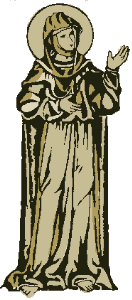Hildegard of Bingen
Visionary
17 September 1179
"Listen: there was once a king sitting on his throne. Around him stood great and wonderfully beautiful columns ornamented with ivory, bearing the banners of the king with great honour. Then it pleased the king to raise a small feather from the ground, and he commanded it to fly. The feather flew, not because of anything in itself but because the air bore it along. Thus am I, a feather on the breath of God."
 Hildegard
of Bingen has been called by her admirers "one of the most important figures in
the history of the Middle Ages," and "the greatest woman of her time."
Her time was the 1100's (she was born in 1098), the century of Eleanor of Aquitaine,
of Peter Abelard and Bernard of Clairvaux, of the rise of the great universities and
the building of Chartres cathedral. She was the daughter of a knight, and when she
was eight years old she went to the Benedictine monastery at Mount St Disibode to be
educated.
Hildegard
of Bingen has been called by her admirers "one of the most important figures in
the history of the Middle Ages," and "the greatest woman of her time."
Her time was the 1100's (she was born in 1098), the century of Eleanor of Aquitaine,
of Peter Abelard and Bernard of Clairvaux, of the rise of the great universities and
the building of Chartres cathedral. She was the daughter of a knight, and when she
was eight years old she went to the Benedictine monastery at Mount St Disibode to be
educated.
The monastery was in the Celtic tradition, and housed both men and women (in separate quarters). When Hildegard was eighteen, she became a nun. Twenty years later, she was made the head of the female community at the monastery. Within the next four years, she had a series of visions, and devoted the ten years from 1140 to 1150 to writing them down, describing them (this included drawing pictures of what she had seen), and commenting on their interpretation and significance.
The community of nuns at Mount St. Disibode was growing rapidly, and they did not have adequate room. Hildegard accordingly moved her nuns to a location near Bingen, and founded a monastery for them completely independent of the double monastery they had left. She oversaw its construction, which included such features (not routine in her day) as water pumped in through pipes. The abbot they had left opposed their departure, and the resulting tensions took a long time to heal.
Hildegard travelled throughout southern Germany and into Switzerland and as far as Paris, preaching. Her sermons deeply moved the hearers, and she was asked to provide written copies. She died on 17 September 1179. Her surviving works include more than a hundred letters to emperors and popes, bishops, nuns, and nobility. (Many persons of all classes wrote to her, asking for advice, and one biographer calls her "the Dear Abby of the twelfth century.")
She wrote 72 songs including a play set to music. Musical notation had only shortly before developed to the point where her music was recorded in a way that we can read today. Accordingly, some of her work is now available on compact disk, and presumably sounds the way she intended. Certainly her compositional style is like nothing else we have from the twelfth century. The play set to music is called the Ordo Virtutum and show us a human soul who listens to the Virtues, turns aside to follow the Devil, and finally returns to the Virtues, having found that following the Devil does not make one happy.
She left us about seventy poems and nine books. Two of them are books of medical and pharmaceutical advice, dealing with the workings of the human body and the properties of various herbs. She also wrote a commentary on the Gospels and another on the Athanasian Creed. Her major works are three books on theology: Scivias ("Know the paths!"), Liber Vitae Meritorum (on ethics), and De Operatione Dei. They deal (or at least the first and third do) with the material of her visions. The visions, as she describes them, are often enigmatic but deeply moving, and many who have studied them believe that they have learned something from the visions that is not easily put into words. Much of her work has recently been translated into English.
Hildegard has undergone a remarkable rise in popularity in the last thirty years, since many readers have found in her visions, or read into them, themes that seem to speak to many modern concerns. Her writings bring science, art, and religion together. She is deeply involved in all three, and looks to each for insights that will enrich her understanding of the others. Her use of parable and metaphor, of symbols, visual imagery, and non-verbal means to communicate makes her work reach out to many who are totally deaf to more standard approaches. In particular, non-Western peoples are often accustomed to expressing their views of the world in visionary language, and find that Hildegard's use of similar language to express a Christian view of reality produces instant rapport, if not necessarily instant agreement.
Hildegard wrote and spoke extensively about social justice, about freeing the downtrodden, about the duty of seeing to it that every human being, made in the image of God, has the opportunity to develop and use the talents that God has given him, and to realize his God-given potential. This too strikes a chord today.
Acknowledgements:
Text adapted from James Kiefer's Christian Biographies
Image from Dioezese-trier (no longer available)